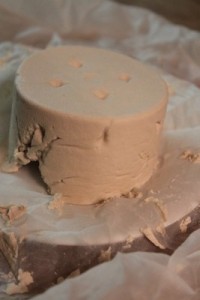Don’t shudder. Hear me out.
My first encounter with the snow white curd was while watching an episode of the Cosby show in the early 90’s. A progressive chef added an ingredient to the soup that Dr. Huxtable found abhorrent. An unmelting, white lump. What was this lump and why did Bill Cosby hate it somuch?
Tofu gets a bad rap. Touted as a meat replacement it is abused in everything from “burgers” to “scrambled eggs”. Applications that are as insulting to the unfortunate bean curd as they are to the poor soul who has to eat it.
Soy milk is similar in composition to cow’s milk and like cow’s milk it can be curdled and pressed into a curd. This makes tofu more similar to cheese than meat. Smooth and sweet, with fresh or sometimes nutty, overtones, Tofu is an interesting ingredient in its own right.
I recently found myself the accidental owner of a 25 pound sack of soybeans. Upon learning that they can’t be used in chili I had two options for them: either learn to make tofu or industrial plastics. A quick search revealed that many different ingredients are used to coagulate soy milk. Unlike the acid or rennet that are used to curdle cow’s milk, soy milk is curdled by means of various salts. Some were traditional. Others decidedly not traditional but more convenient. I could find no clear description of the differences in the tofu produced by the various coagulants. I, therefore, took it upon myself to try all of them and save you the effort.
You’re welcome.
The Experiment
- A fresh batch of soy milk was whipped up and divided into six containers.
- Each coagulant was dissolved into a small amount of water and mixed into the hot milk.
- If a curd formed then it was drained and pressed with 2 kilograms of pressure for 2 minutes into a very small block of tofu.
The resultant curd and whey were weighed to make the process extra sciency! The results that matter, however, are entirely subjective. I poked and tasted each curd to determine differences in their flavor or texture.
Despite my best efforts, there are a great many variables that were not controlled for. The texture of tofu is partially dependent on how hard and for how long the curd is pressed. All the samples were pressed for the same time and pressure. Additionally some sources call for different concentrations of the various coagulants. All the samples used the same concentration of coagulant by weight. It is possible that by varying these variables that all the coagulants could have been made more similar.
Calcium Chloride (CaCl2)
Used in cheesemaking to repair homogenized milk structure and in brewing to alter pH.
Where acquired: Local homebrew store
Flavor: Slightly bitter and a bit nutty
Texture:Smooth and moderately tender
Nigari (Magnesium Chloride (MgCl2))
The traditional coagulant in Japanese tofu. It is part of what is left when sodium chloride is removed from seawater. Sometimes seawater itself was used as a coagulant.
Where acquired: The internet
Flavor: Slightly sweeter than other coagulants
Texture:More cohesive
Epsom Salts (Magnesium Sulfate (MgSO4))
Occurs naturally. Named after a spring in the town of Epsom in Surrey, England. Used as bath salts and as a laxative. Don’t worry- we won’t use that much.
Where acquired: Grocery store
Flavor: Slightly bitter compared to other coagulants
Texture:Slightly more cohesive than Nigari.
Gypsum (Calcium Sulfate (CaSO4))
The traditional coagulant in Chinese tofu. It is mined and used for everything from fertilizer to plaster.
Where acquired: Local homebrew store
Flavor: Sweet and ever so slightly chalky
Texture:Very smooth and extremely tender. More like silken tofu.
Calcium Carbonate (CaCO3)
Used as an antacid and chalk.
Where acquired: Grocery store
Flavor: N/A
Texture:Did not form a curd. Milk thickened slightly and became creamier but I could not tell if this was due to coagulation or just the chalk.
Lemon Juice
I hope I don’t need to explain what lemon juice is.
Where acquired: Grocery store
Flavor: Sour
Texture:Formed a grainy feathery curd. Several attempts with various concentrations failed to produce a good tofu.
Rennet
An enzyme used to coagulate mammalian milks. I included this out of curiosity. As expected it had no effect on the soy milk.
Conclusions
Nigari, while more expensive and difficult to obtain, produced the best flavor. A little nigari goes a long way and my 1 pound bag of the stuff will last for years. In a pinch Epsom salts were much cheaper and worked almost as well.So forgo the tofu burgers and your aunt’s Thanksgiving tofurkey and instead enjoy a delicious stir fry or even pan seared pressed tofu with apples and champagne vinaigrette. Just make sure to choose the right coagulant, because not all tofu is made equal.
Filed under experiments




Thanks for this. I’ve been searching the web to find information on whether or not nigari can be used for curdling milk in cheese making. Reading through your experimental results, I’m guessing the answer is no.